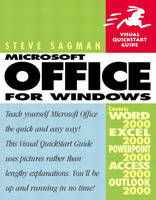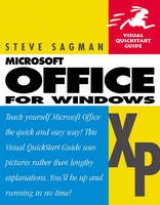
Microsoft Office 2000 for Windows
Peachpit Press Publications (Verlag)
978-0-201-35440-9 (ISBN)
- Titel erscheint in neuer Auflage
- Artikel merken
It's hard enough to find the time to learn a single new program--let alone several at once. But get ready for Microsoft's long-awaited Office 2000, which packages the latest versions of all its most popular business apps, including Word, Excel, PowerPoint, Access, and Outlook. If you, like most people, don't have a lot of time and money to spend getting up to speed, you'll appreciate Microsoft Office 2000: Visual QuickStart Guide.
Divided by Office application, the book guides you right to the information you need and covers all the most important tasks in each program with clear, step-by-step instructions, illustrated with hundreds of helpful screenshots. Office 2000 promises a wealth of exciting new features. Microsoft Office 2000: Visual QuickStart Guide lets you put them to work for you in a hurry.
Steve Sagman is the best-selling author of Using Harvard Graphics and Using Harvard Graphics 3.0, Using Windows Draw, Using Freelance Graphics for Windows, and Getting Your Start in Hollywood (Peachpit). He has written for PC/Computing, Computer Shopper, PC Week PC World, and PC Magazine. Steve Sagman has written or cowritten 17 books on computing. His books have sold well over a million copies, and they've been translated into 12 languages. For information about his titles, visit www.studioserv.com.
I. COMMON OFFICE TECHNIQUES.
1. Introducing Windows.
The Windows Desktop. Key to the Windows Desktop. Using the Mouse. Choosing from Menus and Toolbars. Making Selections in Dialog Boxes. Managing Windows. Switching and Closing Windows.
2. Office Techniques.
Undoing a Change. Opening an Office Document. Creating a New Document. Getting Help from the Office Assistant. Entering Text. Selecting Text Using the Mouse. Selecting and Replacing Text Using the Keyboard. Dragging and Dropping Text. Selecting and Formatting Objects. Copying Formatting Using the Format Painter. Selecting Toolbars to Display. Zooming In and Out. Setting Up the Page. Printing. Saving Your Work. Reopening a Saved File. Quitting an Office Application.
II. MICROSOFT WORD.
3. Introducing Word 2000.
The Steps to Creating a Word Document. Starting Word. The Word Window. Key to the Word Window.
4. Entering and Editing Text.
Starting a New Document. Starting a Document Using a Wizard or Template. Entering Text. Turning On Paragraph Marks. Editing Text. Finding Text. Replacing Text. Using Print Layout View. Using Outline View. Using Web Layout View.
5. Formatting Text.
Changing the Font and Font Size. Boldfacing, Italicizing, and Underlining. Expanding and Condensing Character Spacing. Changing the Case of Text. Using Special Font Effects. Selecting Paragraphs. Using the Ruler to Indent Paragraphs. Setting a Different First Line Indent. Indenting Using the Paragraph Dialog Box. Double-Spacing Paragraphs. Centering and Justifying Paragraphs. Setting Tabs. Adding Bullets to Paragraphs. Numbering Paragraphs. Finding and Replacing Formatting. Using Styles. Choosing a Text Style. Creating a Paragraph Style. Modifying a Paragraph Style. Creating a Character Style.
6. Formatting Pages.
Changing the Page Size and Orientation. Changing the Margins. Setting Up Headers and Footers. Creating Multiple Sections. Paginating the Document. Numbering Pages. Setting Up Multiple Columns. AutoFormatting a Document.
7. Creating Tables.
Starting a Table. Drawing a Table. Drawing a More Complex Table. Entering Data in a Table. Aligning Data in a Table. Totaling Numeric Data. Deleting Data from a Table. Inserting Rows and Columns. Merging Cells. Turning On Borders and Shading. Converting Text to a Table.
8. Special Word Techniques.
Automatically Correcting Typos. Inserting Symbols from the Wingdings Font. Using AutoText. Printing Envelopes. Envelope Printing Options. Saving a Document as a Template. Using Automatic Saves. Creating Form Letters Using Mail Merge.
9. Word and the Web.
Inserting Hyperlinks. Editing a Hyperlink. Previewing a Document as a Web Page. Saving a Document as a Web Page. Using the Web Wizard to Create a Website. Formatting a Document with a Web Theme.
III. MICROSOFT EXCEL.
10. Introducing Excel 2000.
The Steps to Creating an Excel Sheet. Starting Excel. The Excel Window. Key to the Excel Window. Starting a New Workbook.
11. Entering Data and Formulas.
Starting with a Template. Moving Within a Sheet. Typing Data into a Cell. Editing Cells. Adding a Hyperlink. Filling an Entry Range. AutoFilling a Range. Entering Simple Calculations. Building a Simple Formula. Summing Columns and Rows. Totaling a Column Using the Sum Function. Copying Formulas to Adjacent Cells. Averaging Numbers Using the Average Function. Calculating Numbers in Nonadjacent Cells. Building Formulas Using the Paste. Function Wizard.
12. Structuring the Sheet.
Enlarging Columns and Rows. Inserting Rows and Columns. Inserting and Deleting Cells. Moving and Copying Data. Freezing the Headings.
13. Formatting the Sheet.
Choosing an AutoFormat. Formatting Text. Centering a Title Above a Range. Formatting Numbers. Adding Borders to a Range. Adding Shading to a Range. Applying Conditional Formatting. Creating a Style. Selecting a Style.
14. Using Excel Charts.
Creating a Default Chart. Creating a Chart Using the Chart Wizard. Modifying a Chart. Modifying the Chart Type. Modifying the Chart Area, Plot Area, and Gridlines. Modifying the Title, Axes, and Legend. Modifying a Data Series. Adding Data to a Chart. Adding Data Tables and Trendlines. Creating a PivotTable Report. Creating a PivotChart Report.
15. Excel Database Techniques.
Setting Up the Database. Creating a Form. Sorting the Database. Extracting Data. Totaling Numeric Data in a Database.
16. Special Excel Techniques.
Changing to Another Sheet. Naming Sheets. Referring to Data from Other Sheets in Formulas. Consolidating to a Sheet. Naming Ranges. Auditing a Workbook. Seeking Goals. Tracking Changes. Reviewing Changes. Inserting Comments. Protecting and Sharing a Workbook. Merging Workbooks.
17. Excel and the Web.
Opening a Document on the Web. Running a Web Query. Saving a Workbook as a Web Page.
IV. MICROSOFT POWERPOINT.
18. Introducing PowerPoint 2000.
The Steps to a PowerPoint Presentation. Starting PowerPoint. The PowerPoint Window. Key to the PowerPoint Window.
19. Building a Presentation.
Starting a New Presentation. Using the AutoContent Wizard. Using a Design Template. Using a Sample Presentation. Changing Views. Adding Slides.
20. Outlining the Presentation.
Switching to Outline View. Entering the Text. Replacing Existing Text. Reorganizing the Slides. Showing the Slide Titles Only. Inserting and Deleting Slides.
21. Creating Text Slides.
Creating a Text Slide. Filling in Text Placeholders. Selecting Text Blocks. Moving and Resizing Text Blocks. Formatting Text. Rearranging Text in a Block.
22. Creating Chart Slides.
Starting a Chart. Replacing the Sample Data on a Datasheet. Changing the Chart Type. Saving a Custom Chart Format. Displaying a Legend and Gridlines. Adding Chart Titles. Adding Data Labels. Arranging Data by Row vs. by Column.
23. Formatting Charts.
Formatting Chart Elements. Cutting a Pie Chart Slice. Creating High-Low-Close Charts. Switching Between 2-D and 3-D Chart Types. Changing the View of 3-D Charts. Moving and Resizing Charts.
24. Creating Org Charts and Tables.
Starting an Organization Chart. Entering Names and Titles. Adding Members. Formatting the Boxes, Text, and Lines. Rearranging the Org Chart. Finishing the Chart and Leaving Microsoft . Organization Chart. Starting a Table. Entering the Data and Formatting the Table.
25. Customizing a Presentation.
Selecting a New Design. Changing the Color Scheme. Switching to Slide and Title Master Views. Changing the Background Color and Shading. Changing the Text Fonts. Changing Header and Footer Information. Adding a Logo to the Background. Saving a Custom Design. Working in Slide Sorter View. Reordering Slides. Changing the Design in Slide Sorter View. Duplicating and Deleting Slides.
26. Drawing on Slides.
Drawing Shapes and Lines. Adding Predefined Shapes and Text Boxes. Adding Shadows and 3-D Effects. Making Text Conform to Shapes. Grouping and Ungrouping Shapes. Rearranging and Rotating Shapes. Using Clip Art.
27. Creating Slide Shows.
Adding Transition Effects. Adding Preset Animation. Creating Custom Animations. Adding Audio and Video. Adding Action Buttons. Setting Up the Show. Displaying the Show.
28. PowerPoint and the Web.
Adding a Hyperlink. Opening a Presentation on the Web. Previewing a Presentation as a Web Page. Saving a Presentation as a Web Page.
V. MICROSOFT ACCESS.
29. Introducing Access 2000.
The Steps to Creating an Access Database. Starting Access. The Access Window. Key to the Access Window.
30. Creating a Database.
Creating a New Database. Saving a New Database. Starting a Database Using a Wizard. Viewing the Database.
31. Creating a Table.
Entering Data in a Table. Editing Data in a Table. Printing a Table. Creating a Table. Saving a Table. Creating a Table Using the Table Wizard. Adding a Field to the Table in Design View. Setting the Field Size and Format. Entering a Caption and Default Value for a Field. Requiring and Indexing a Field.
32. Creating a Form.
Entering Data in a Form. Viewing and Editing Records Using a Form. Creating and Saving a Form. Creating a Form Using the Form Wizard. Opening the Form in Design View. Moving a Control. Sizing a Control and Moving Labels. Independently. Adding Labels. Formatting Labels. Adding a Combo Box. Setting the Form and Control Properties.
33. Working with Records.
Finding a Match in a Form or a Table. Sorting Records. Creating a Filter. Adding an Expression to a Filter.
34. Using Queries.
Creating and Running a Select Query. Saving a Query and Printing the Results. Starting a Query Using the Simple Query Wizard. Adding Criteria to a Query. Calculating Totals in a Query. Finding Duplicate or Unmatched Records. Updating Table Records Using an Update Query. Deleting Table Records Using a Delete Query. Appending Table Records Using an Append Query. Creating a Table of Query Results Using a Make-Table Query. Creating a Crosstab Query.
35. Creating a Report.
Viewing and Printing a Report. Starting a Report Using an AutoReport. Starting a Report Using the Report Wizard. Revising a Report in Design View. Sorting and Grouping Records in a Report. Choosing an AutoFormat for the Report. Creating Charts and Labels.
36. Access and the Web.
Creating and Saving a Data Access Page. Starting a Data Access Page Using the Page Wizard. Creating a Data Access Page Using an AutoPage. Revising the Page in Design View. Changing the Theme in Design View. Inserting a Chart in a Data Access Page. Inserting a PivotTable in a Data Access Page. Inserting a Spreadsheet in a Data Access Page. Adding a Hyperlink Field. Adding a Hyperlink.
VI. MICROSOFT OUTLOOK.
37. Introducing Outlook 2000.
The Steps to an Outlook Management System. The Steps to Creating an Access Database. Starting Outlook. Starting Access. The Outlook Inbox Window. Key to the Inbox Window. Connecting to the Internet. Using Outlook Today.
38. Reading Messages.
Collecting Messages. Reading a Message. Closing a Message. Viewing the Folder List. Replying to a Message. Forwarding a Message. Printing a Message. Changing a View. Finding Text in a Message. Deleting a Message.
39. Sending Messages.
Setting Mail Format Options. Creating Stationery. Creating a Signature. Starting and Addressing a Message. Entering and Formatting the Text. Starting a Message Using a Different. Format or Program. Setting Message Options. Attaching a File or an Item to a Message. Inserting an Object in a Message. Saving and Sending the Message.
40. Managing Your Mailbox.
Moving a Message to a Folder. Creating a Folder. Organizing Messages. Creating a Message Rule. Moving or Deleting a Folder.
41. Keeping a Contacts List.
Setting Contact Options. Adding a Contact. Adding a Contact from an E-mail Message. Deleting a Contact.
42. Scheduling Tasks and Meetings.
Looking at Tasks. Setting Task Options. Adding a Task. Assigning a Task. Changing the Status of a Task. Viewing the Calendar. Setting Calendar Options. Adding an Item to the Calendar. Creating a Recurring Appointment. Inviting Attendees to a Meeting. Adding an All-Day Event.
Index.
| Erscheint lt. Verlag | 10.6.1999 |
|---|---|
| Verlagsort | Berkeley |
| Sprache | englisch |
| Maße | 229 x 180 mm |
| Gewicht | 753 g |
| Themenwelt | Informatik ► Betriebssysteme / Server ► Windows |
| Informatik ► Betriebssysteme / Server ► Windows Server | |
| Informatik ► Office Programme ► Office | |
| ISBN-10 | 0-201-35440-3 / 0201354403 |
| ISBN-13 | 978-0-201-35440-9 / 9780201354409 |
| Zustand | Neuware |
| Informationen gemäß Produktsicherheitsverordnung (GPSR) | |
| Haben Sie eine Frage zum Produkt? |
aus dem Bereich



